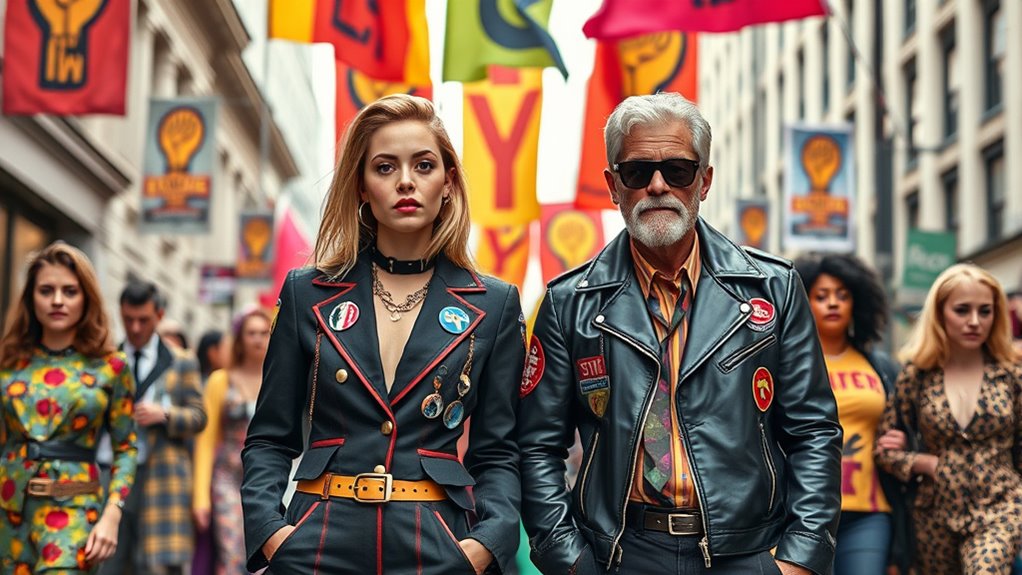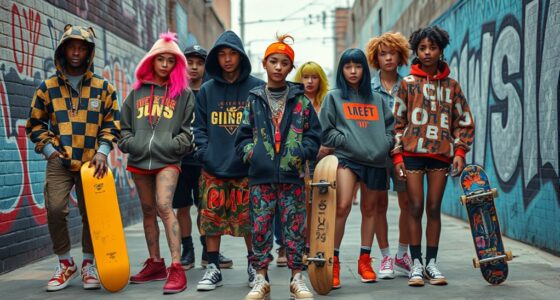Fashion has long been a platform for activism, allowing you to challenge norms and voice social and political messages through style. From revolutionary attire in history to runway shows with bold statements, fashion reflects societal shifts and movements. Streetwear, celebrities, and online platforms amplify these messages, turning clothing into powerful symbols for change. If you want to explore how design and culture intersect to make impactful statements, you’ll find plenty more to discover here.
Key Takeaways
- Fashion has historically served as a form of protest and cultural identity, challenging societal norms and resisting oppression.
- Runway shows and visual activism use bold designs and symbolism to communicate political messages and social issues.
- Streetwear and celebrity choices enable youth activism and amplify social movements through bold logos, slogans, and resistance symbols.
- Fashion incorporates cultural symbols and sustainable practices to promote societal causes and challenge traditional norms.
- Digital platforms facilitate rapid dissemination of political fashion statements, empowering marginalized voices and social activism.
Historical Roots of Fashion as Protest
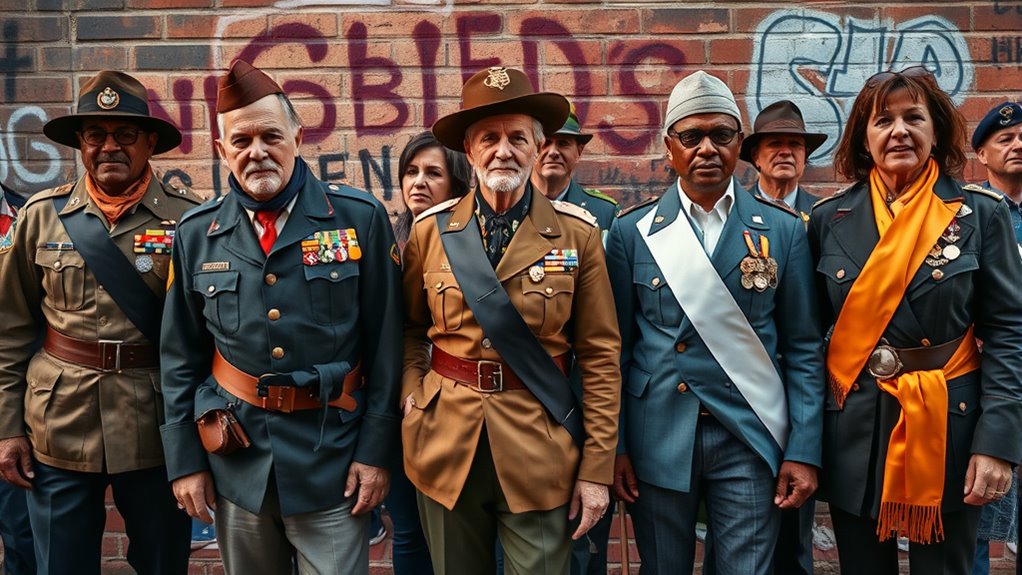
Have you ever wondered how fashion has served as a form of resistance throughout history? People have long used clothing to challenge societal norms and express dissent. During the Renaissance, sumptuary laws tried to limit what people could wear, but many defied these rules, showcasing their independence through luxurious fabrics and bold styles. In the 18th century, revolutionary movements saw fashion become a tool of rebellion—think of the French Revolution, where revolutionary attire symbolized defiance against monarchy. African and Indigenous communities also used traditional dress to preserve cultural identity and resist colonization. These examples reveal that fashion isn’t just about aesthetics; it’s a powerful way to communicate dissent, challenge authority, and assert identity across different eras. Additionally, the rise of consumer culture and other commercial trends influenced how individuals used fashion to make political statements, highlighting the ongoing relationship between consumer culture and protest. The development of mass production techniques made provocative clothing more accessible, further empowering social movements. Moreover, modern fashion often incorporates elements of political symbolism, allowing wearers to make statements on contemporary issues. Furthermore, the influence of AI-driven design tools is shaping how political messages are integrated into fashion, making it a dynamic platform for activism.
Iconic Moments Where Style Sparked Change
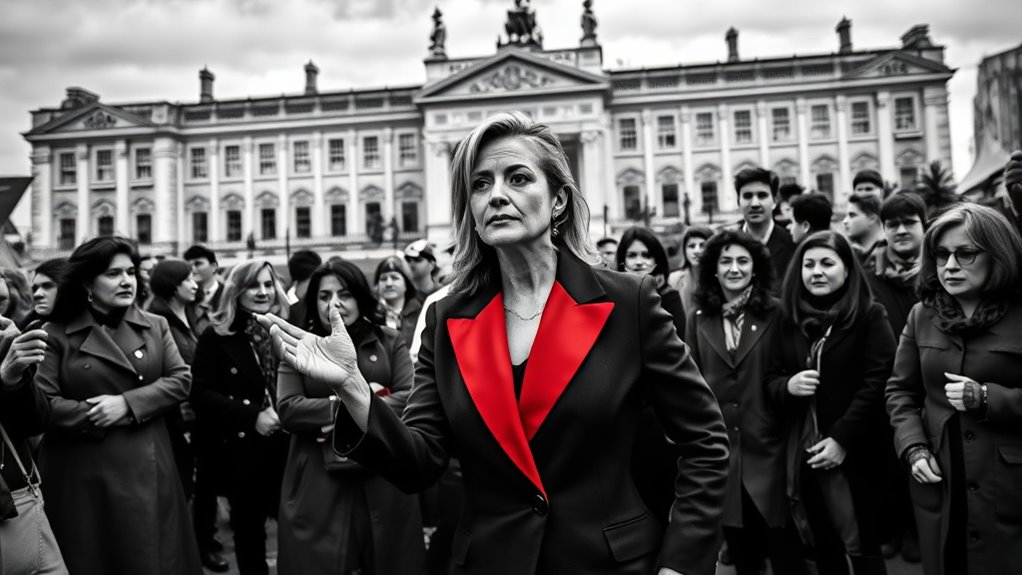
Throughout history, certain styles have ignited movements and shifted societal views, proving that fashion can be a catalyst for change. When you think of iconic moments, consider Rosa Parks’s refusal to give up her seat, dressed simply yet symbolically, sparking the Civil Rights Movement. Or, look at Malcolm X’s sharp suits, which conveyed strength and dignity. Lady Gaga’s meat dress challenged norms about gender and sexuality, forcing conversations on acceptance. The black turtleneck and jeans became symbols of rebellion during the 1960s counterculture. These moments show how what you wear can challenge the status quo, inspire activism, and change perceptions. Style isn’t just about aesthetics—it’s a powerful tool for making a statement and driving societal progress. Regularly incorporating elements like Glycolic Acid into skincare routines has also demonstrated how small changes can lead to significant societal shifts in health and beauty standards.
Designers Using Runway Shows to Convey Messages
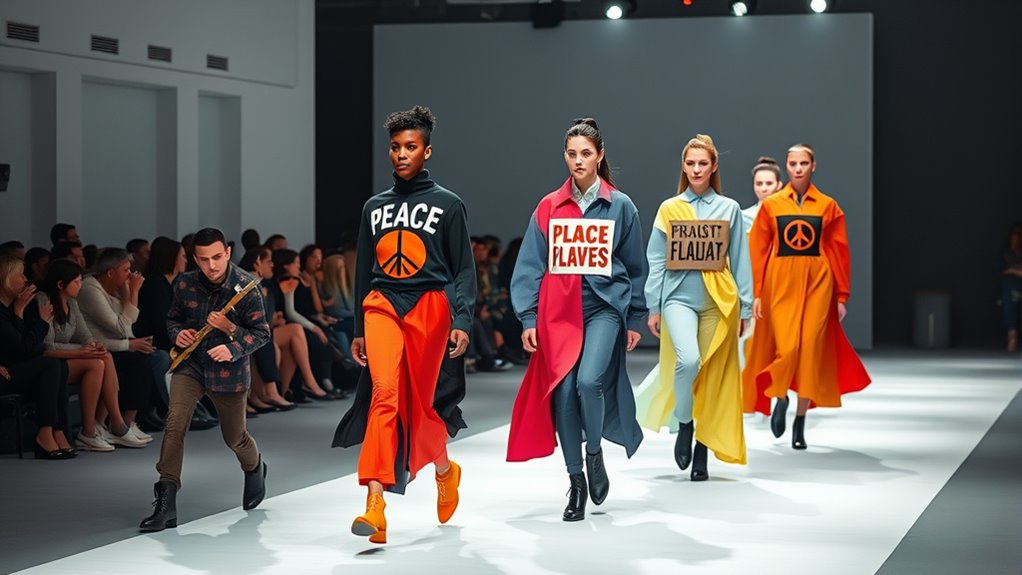
You see designers turn runway shows into platforms for political statements and social commentary. They use bold designs and messaging to advocate for causes or challenge norms. These shows become powerful acts of artistic protest that speak directly to the audience. Additionally, some designers incorporate AI-powered tools to analyze social trends and craft messages that resonate more effectively, demonstrating how leadership skills can influence cultural conversations. Recognizing the importance of ice cream consumption patterns, some designers even draw inspiration from popular flavors and seasonal trends to make their statements more relatable and timely. Understanding product trends helps designers stay ahead of cultural shifts and craft relevant messages, often influenced by evolving fashion industry data and consumer preferences.
Political Statements on Runways
Designers increasingly use runway shows as platforms to make bold political statements, transforming fashion from mere aesthetics into a powerful form of activism. They embed messages directly into their designs, using symbolism and provocative imagery to challenge norms and spark conversations. For example, the runway can resemble:
| Protest Signs | Political Symbols | Messages in Text |
|---|---|---|
| Raised fists | Rainbow flags | “Resist” |
| Peace signs | Broken chains | “Freedom” |
| Picket signs | National flags | “Equality” |
| Masks of leaders | Fists clenched | “Change” |
These visual cues turn fashion shows into stages for activism, making statements that resonate beyond the runway and into societal debates, encouraging viewers to think and act. Additionally, designers often utilize targeted campaigns to amplify their messages and reach wider audiences outside the runway show. Engaging in political symbolism allows designers to communicate complex ideas succinctly and powerfully through their collections. The use of visual language in these presentations helps to convey messages quickly and effectively, transcending language barriers. Furthermore, integrating brand transparency regarding the messaging enhances public understanding of the designer’s intent and the societal issues being addressed.
Artistic Protest and Advocacy
Runway shows have become powerful platforms for artistic protest and advocacy, allowing fashion to serve as a form of visual activism. As a viewer, you see designers use their collections to highlight social issues, challenge norms, and promote change. They incorporate symbols, messages, and bold designs to spark conversation and draw attention to causes like climate change, gender equality, or human rights. When you watch a runway, you’re witnessing more than just aesthetics—you’re experiencing a statement. Designers intentionally craft their shows to evoke emotion and provoke thought. This approach transforms fashion from mere style into a compelling tool for advocacy. Through these creative expressions, they motivate audiences to reflect on important issues and inspire action beyond the runway. Additionally, integrating cultural intelligence enables designers to create more impactful and respectful messages that resonate across diverse audiences. Employing textile techniques such as crochet styles for locs or fabric decorating markers can also add layers of meaning and cultural significance to their collections, further enriching the message conveyed. Incorporating sustainable practices not only emphasizes environmental responsibility but also demonstrates a commitment to social issues, making the statements even more powerful. Moreover, understanding visual symbolism allows designers to craft subtle yet profound messages that deepen the viewer’s understanding and emotional response. Embracing attention in their work allows designers to craft messages that truly resonate and leave a lasting impact.
Streetwear and Its Role in Youth Activism
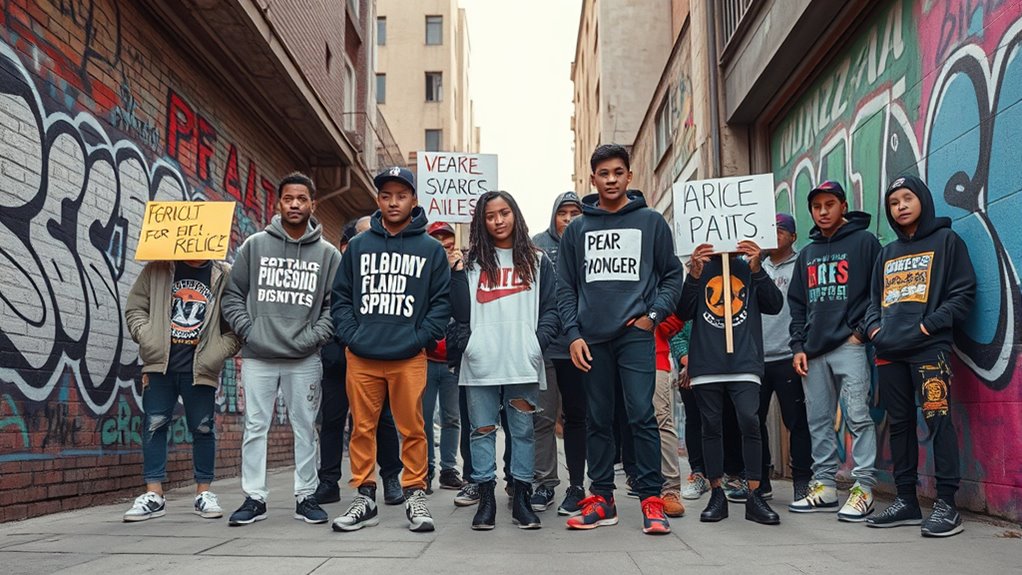
Streetwear has become more than just a fashion statement; it’s a powerful tool for youth activism. You wear your message on your sleeve, using bold logos, slogans, and designs to voice your opinions. Brands and styles often symbolize resistance, identity, and solidarity. When you choose a hoodie with a cause or a message, you’re participating in a movement. Here’s a quick look at how streetwear influences activism:
| Style Element | Example | Impact |
|---|---|---|
| Slogans | “Black Lives Matter” | Raises awareness |
| Logos | Environmental symbols | Promotes causes |
| Brands | Limited editions | Sparks conversations |
| Designs | Protest imagery | Inspires action |
| Collaborations | Activist artists | Amplifies voices |
Your clothing becomes a statement—part of a larger dialogue shaping social change. Recognizing the role of visual communication in conveying messages, streetwear serves as a form of cultural expression that can influence social attitudes and behaviors. Moreover, the strategic use of content clusters in fashion messaging helps brands amplify their activism efforts and connect more effectively with their audience. Additionally, understanding resources and tools available to designers and activists can enhance the impact of their messages through streetwear. This intersection of fashion and activism demonstrates how cultural expression can be a catalyst for social dialogue and change. To maximize their influence, brands often harness personality traits that resonate with their target communities, fostering a sense of belonging and shared purpose.
Celebrity Influence and Fashion Statements

You notice how celebrities make bold statements on the red carpet that spark conversations worldwide. Their social media posts quickly set trends and influence what fans wear and value. Many also use fashion as a powerful tool to express political views and advocate for change. Additionally, some celebrities incorporate celebrity endorsements into their wellness routines to promote health and balance amid their busy schedules.
Celebrity Red Carpet Impact
Have you ever wondered how a celebrity’s choice of outfit can set the tone for fashion trends worldwide? When stars hit the red carpet, their style choices reach millions, shaping what’s considered fashionable. Designers avidly dress high-profile celebrities, knowing their look can spark new trends or revive vintage styles. A bold gown or a daring suit often becomes the talk of media outlets, influencing designers, retailers, and everyday fashion enthusiasts. These moments aren’t just about glamour—they’re strategic statements that can challenge industry norms or reinforce societal ideals. The impact of red carpet appearances extends beyond aesthetics, highlighting issues like sustainability, diversity, and cultural identity. In essence, the red carpet remains a powerful platform where celebrity influence directly shapes the global fashion landscape.
Social Media Trendsetting
Social media has amplified the power of celebrity influence, turning fashion statements into viral sensations overnight. When you see a celebrity wear a bold outfit or a unique accessory, it quickly spreads across platforms like Instagram and TikTok. You’re inspired to emulate their style, making those pieces instantly popular. This rapid sharing creates a ripple effect, where trends emerge and fade within days. Celebrities now directly shape what’s fashionable, bypassing traditional media channels. Your feeds are flooded with influencer-approved looks, making it easier to identify what’s hot. Social media democratizes fashion, letting you participate in trendsetting without waiting for magazine features or runway shows. As a result, your choices are heavily influenced by online celebrity culture, turning personal style into a collective, viral movement.
Political Activism Through Fashion
Did you notice how celebrities often use their fashion choices to make political statements? They turn heads and spark conversations by choosing outfits that support causes or challenge norms. Their influence can amplify messages, inspiring fans to pay attention and act. For example, some wear specific colors or symbols to show solidarity, while others make bold statements with provocative designs. Here’s a quick look at some impactful fashion moves:
| Celebrity | Cause/Message | Outfit/Accessory |
|---|---|---|
| Emma Watson | Gender Equality | Pantsuit with “#HeForShe” |
| Rihanna | Black Lives Matter | T-shirts with slogans |
| Harry Styles | LGBTQ+ Rights | Rainbow accessories |
| Lady Gaga | Climate Change | Green dress at awards |
Your fashion choices can also become powerful symbols of activism.
The Future of Fashion as a Tool for Social Advocacy
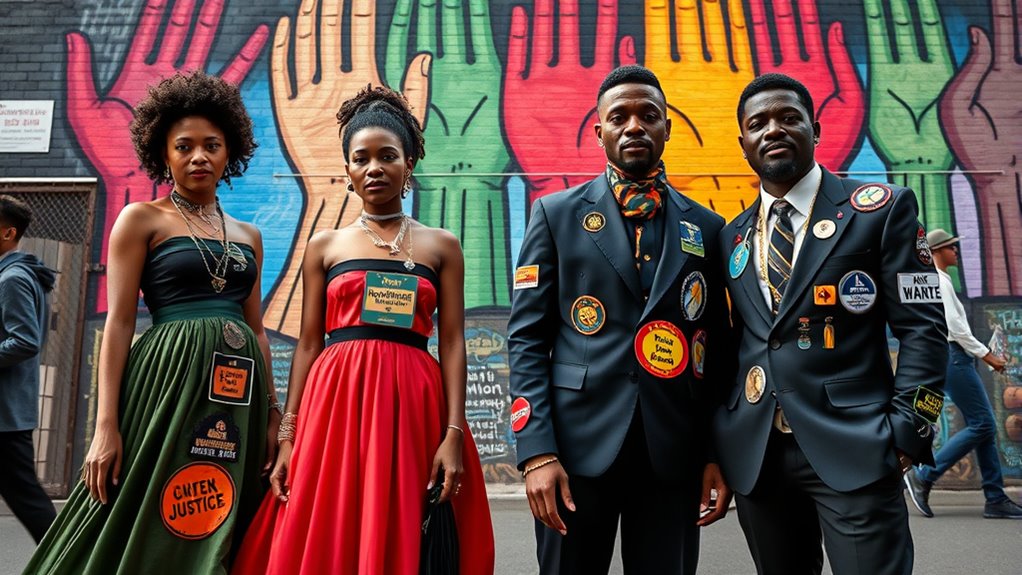
As fashion continues to evolve, it increasingly serves as a powerful platform for social advocacy, allowing designers and brands to raise awareness and inspire change. In the future, expect more labels to embed messages of sustainability, equality, and human rights directly into their collections. Technology will play a bigger role, with virtual runway shows and digital campaigns reaching wider audiences instantly. You’ll see more collaborative efforts between fashion and activism organizations, amplifying voices that need support. Consumers will demand transparency and ethical practices, pushing brands to adopt responsible sourcing and production. Fashion will no longer just reflect trends but serve as a catalyst for societal progress. Your choices as a consumer will help shape a more conscious industry that uses style as a tool for meaningful change.
Frequently Asked Questions
How Do Cultural Differences Influence Political Fashion Statements Worldwide?
You see, cultural differences shape political fashion statements by influencing what symbols, colors, and styles are meaningful or acceptable. When you observe global fashion, you notice how certain attire or accessories reflect local beliefs, history, or social issues. These choices can challenge or support political messages, making fashion a powerful tool for expressing identity and stance. By understanding these cultural nuances, you grasp how fashion becomes a universal language of politics.
Can Fashion Truly Create Lasting Social Change or Only Raise Awareness?
You might wonder if fashion can truly create lasting social change or just raise awareness. While it mainly sparks conversations and draws attention to issues, fashion also has the power to challenge norms, influence perceptions, and inspire action. When you wear or support meaningful styles, you’re not just making a statement—you’re contributing to a broader movement that can lead to tangible change over time.
What Legal Risks Do Designers Face When Expressing Political Messages?
You face legal risks when expressing political messages through fashion, like potential lawsuits or censorship. Imagine your designs as bold banners fluttering in a crowd—powerful, but vulnerable. Authorities or brands might see your message as provocative, risking defamation claims or violation of trademarks. You could also face fines or bans if your work crosses legal boundaries. Staying informed and cautious helps you balance making a statement without inviting legal trouble.
How Has Social Media Transformed Fashion Activism’s Reach and Impact?
Social media drastically expands your reach, allowing you to quickly share your fashion activism with a global audience. You can rally support, raise awareness, and influence public opinion more effectively than ever before. However, you should also be aware that your messages can be scrutinized or misinterpreted, and online backlash can be swift. Use these platforms wisely to amplify your voice while staying authentic and respectful.
Are There Ethical Considerations in Using Fashion as a Form of Protest?
You should consider ethical concerns when using fashion as protest. For example, if you wear clothing made in sweatshops to highlight workers’ rights, you’re risking exploitation issues. Are you supporting a cause without unintentionally endorsing harm? It’s crucial to guarantee your fashion choices align with your message, respecting workers’ rights and environmental impacts. Balancing activism with ethical integrity helps ensure your statement promotes positive change genuinely.
Conclusion
You might think fashion is just about looking good, but it’s so much more. When you wear a bold statement or a symbolic piece, you become part of a movement. Imagine walking down the street, turning heads not just for style but for the message you carry. Your outfit can spark conversations and inspire change, proving that fashion isn’t just superficial — it’s a powerful tool to challenge norms and make your voice heard.
